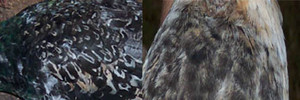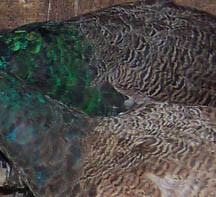

We no longer sell Peafowl but I am leaving this page up as informational.
PEAFOWL BASICS:
A male is a Peacock, a female is a Peahen, a baby is a Peachick, collectively they are PEAFOWL.
Peafowl come in many COLORS and each Color comes in several PATTERNS.
The COLORS are:
Blue (the naturally occuring color of Parvo Cristatus)
and the following mutations of Blue....
Cameo
Purple
Charcoal
Opal
Bronze
Peach
Midnight
Jade
White (white is considered a Color but is best thought of as a pattern as it covers the true genetic "color" of the bird - see more below)
Green ~ Green Peafowl are actually a totally different species (Parvo Muticus) than Blue and its mutations BUT it can cross with Blue producing a Spalding, which is a fertile hybrid. There are 3 known sub-species of green peafowl: Javanese (muticus muticus), Indo-Chinese (muticus imperator), and Burmese (muticis spicifer).
The PATTERNS are:
Wild-Type (referred to in Blue as India Blue) - the Barred wing pattern
Black Shoulder - the Solid color wing pattern
Pied - white patches on any color bird
Silver Pied - a Pied pattern with over 80% white
White Eye - some to all of the eyes in the peacock's trane are white rather then colored, harder to identify in hens, can be identified in chicks by white tipped back feathers IF you are looking for it but it is very subtle.
White - I consider White a Pattern, see note above - white totally covers the genetic color and any other pattern of the bird so a White Pea can carry the genes of another color hidden by the white. A bird can genetically be a Black Shoulder Purple but if it carries 2 white genes it will BE totally white even though it still carries and can pass on the other genes.
A single bird can have (genetically or visible) more than one pattern, for example a White Eye Silver Pied Purple.
SPLITS:
The term "Split to" refers to the bird carrying a single recessive gene. The trait the bird is Split to will not be visible since a recessive gene requires 2 copies to be a visible trait. However, knowing that the bird is split tells you that it can produce whatever it is Split to if bred to another bird that carries 1 or 2 of that gene. For example: Black Shoulder Blue (split to Opal) looks just like a Black Shoulder Blue, but if bred to an Opal you can produce approximately 50% Opal offspring and if bred to another BS Blue (split to Opal) you can expect approximately 25% Opal off spring and 50% Split to Opal.
Confused yet? It gets worse......
Sex-Linked Colors:
Cameo and Purple are Sex-Linked Colors which means a Cameo or Purple cock can sire his same color FEMALE off spring with another color hen but can ONLY sire his same color MALE offspring with a hen of his same color. Bred to any other color hen the male offspring will be Split to Purple or Cameo. See "Split to" above.
Enough of the confusing stuff.....
A peacock begins growing his trane (his long "tail" feathers) at 18 mos-2 years old but will not have a full trane until usually his 4th year. Each year after that he will have more "eyes" in his trane and it will get fuller and longer.
A peahen will not lay eggs until her second year. Peahens normally lay on the ground in a shallow depression. This makes them an easy target for predators when they begin sitting on the eggs, so care MUST be taken to safely pen up peas during breeding season (from the start of warm weather in the late winter/early spring until hot/dry weather around mid-July in our area). Every year we get calls from people looking for hens to replace ones they have lost. Adult hens are expensive and hard to find so PROTECT the ones you have!
Peachicks hatch after a 28 day gestation and hatch with a few flight feathers. This means they are able to fly a bit straight out of the egg. So no worries if your hen decides to set her nest up off the ground!
OUR PEAFOWL:
We currently have 3 Peafowl pens:
The BLUE pen contains a Black Shoulder Blue Peacock in with India Blue, Black Shoulder Blue, and Wild-Type Opal hens. This pen produces BS Blue, India Blue (split to BS), India Blue (split to BS and Opal), and an occassional Dark Pied Blue.
The PURPLE pen contains a Wild-Type Purple Peacock (Split to BS) in with Wild-Type, BlackShoulder, Pied, and Silver Pied Purple hens. This pen produces chicks of the same types as the parents.
The WHITE/PIED pen contains a Silver Pied Blue peacock in with White, Blue Pied, and Blue Silver Pied hens.This pen produces chicks of the same types as the parents.
We sell peachicks and peafowl hatching eggs when they are available.
Eggs are $10 each plus Priority Mail shipping and a $2.50 handling charge to cover the amount of bubble wrap and packing peanuts we use.
Chick prices start at $35 and go up from there depending on color, age, and sex.
Where to Find Us:
Gardienne Wings
Heritage & Exotic Fowl
Gardienne Myotonic Goats
Sumerduck, VA 22742
Visitors welcome by appointment only!
Email: GardienWings@aol.com











































